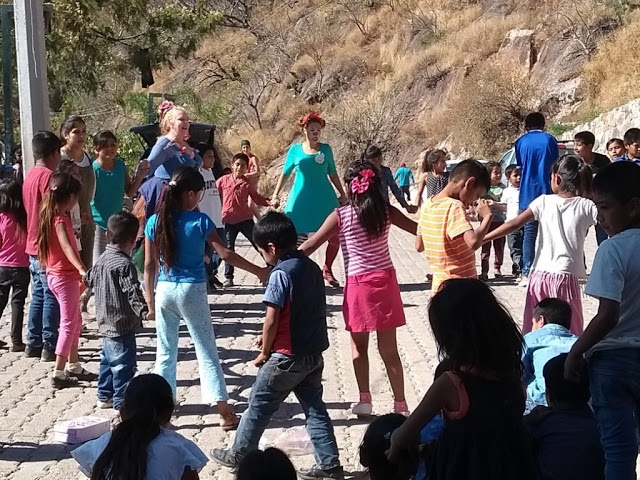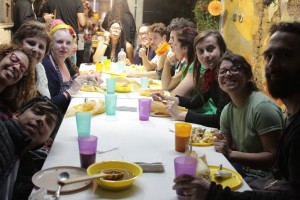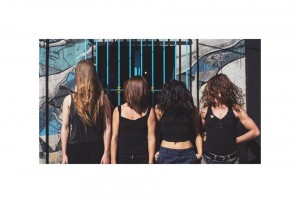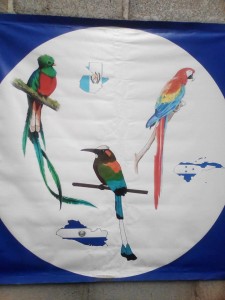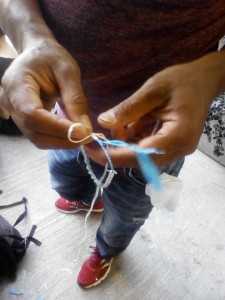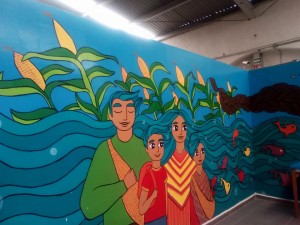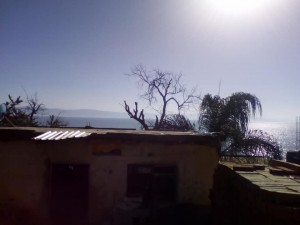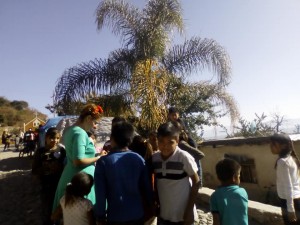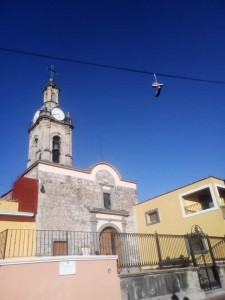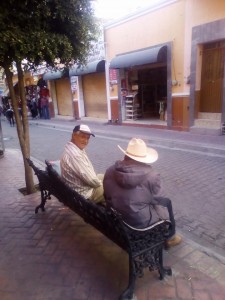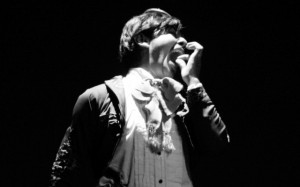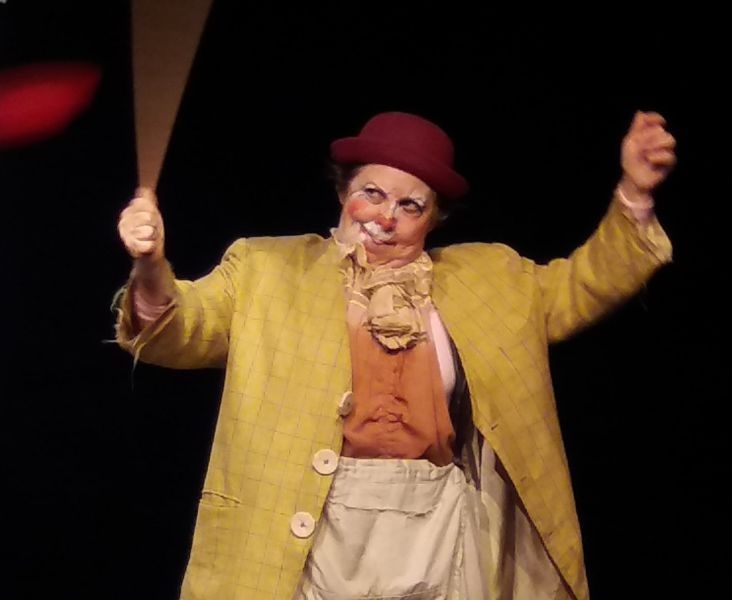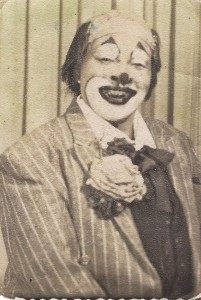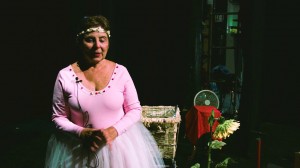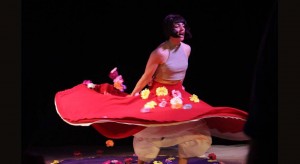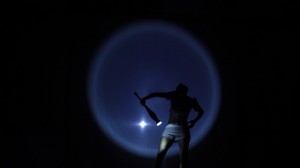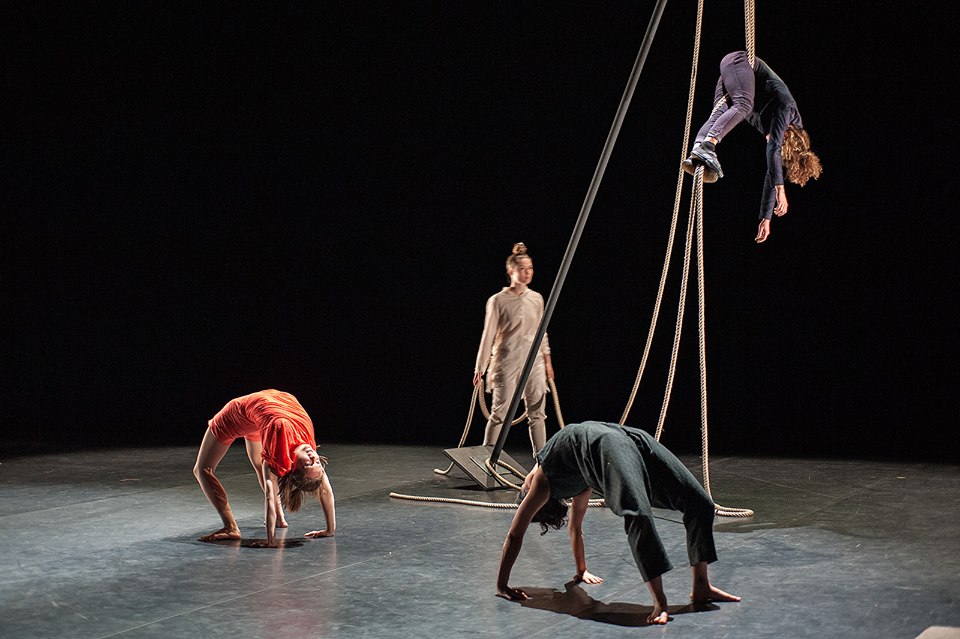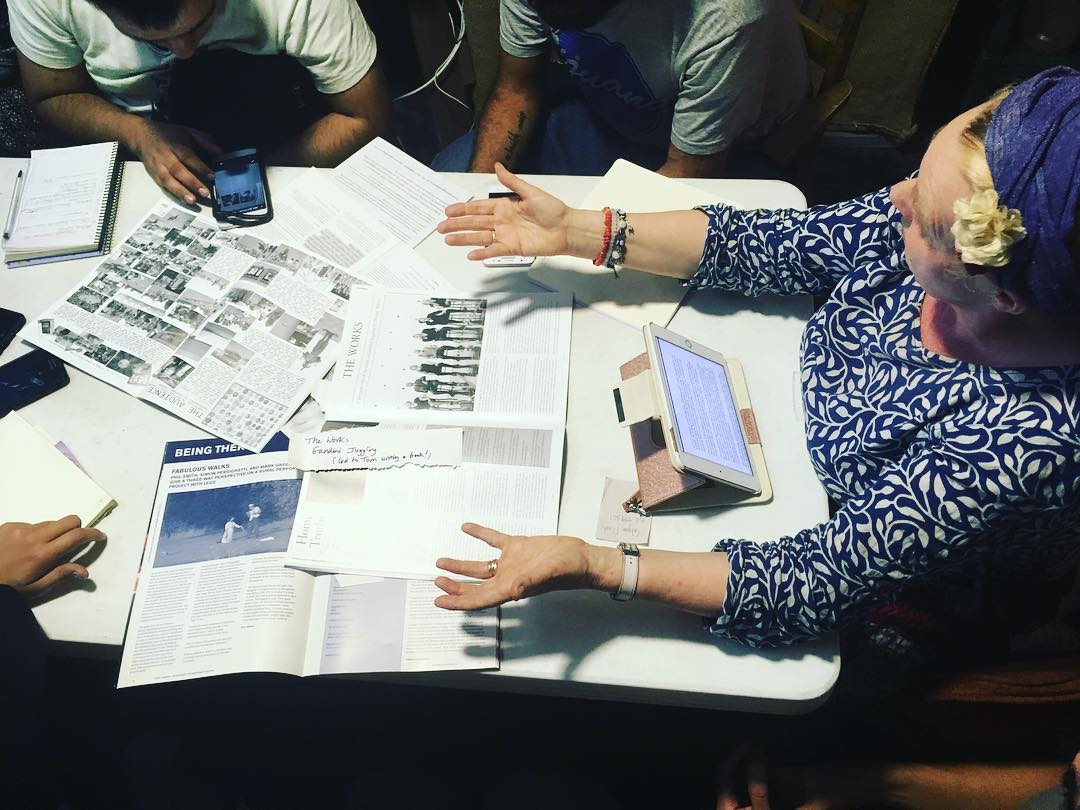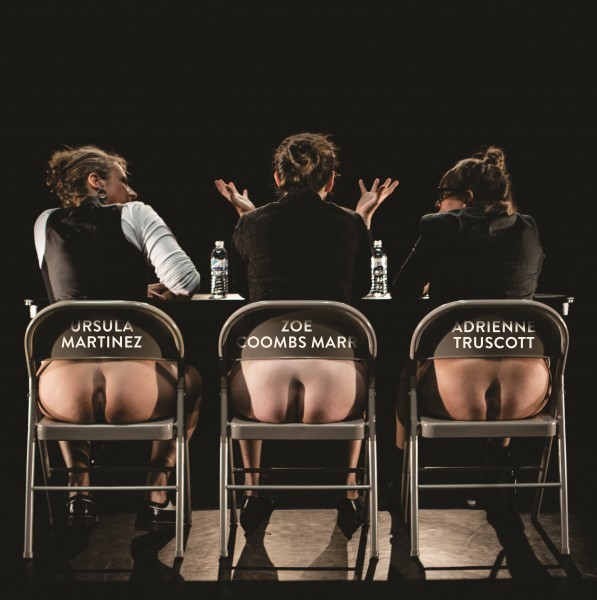Dorothy Max Prior goes on the road in Mexico with Caravanas Ficho, an enterprising outreach and community engagement programme created by Ficho Festival, taking circus and street arts to otherwise excluded people in Guadalajara and other parts of Jalisco state
So here we are, a motley crew gathering in Caligari, a shabby-chic cafe in Guadalajara’s hipster Colonia Americana district: artists, producers, and the Ficho Festival volunteers, a bunch of feisty young circus students and budding producers known as the ‘Ficholitos’. While I’m busy attaching brightly coloured model birds to my teased-up hair, and bells and horns to my multi-layered skirt, others are loading up the cars with props, sound systems and bottled water. And we’re off, the first Caravana Ficho of the 2017 festival programme.
We’re not going far: today, our destination is a suburb of Guadalajara, on a hill overlooking the city. I say ‘suburb’, but that might conjure up an image of middle-class affluence, and this is a far cry from that image. We park up outside a church, in a district that could reasonably be described as dirt-poor. Steep, cobbled streets littered with discarded trash, a few battered old American cars gathering dust, and a rickety school bus heaving itself up the hill. Houses with no facades, like abandoned, oversized dolls’ houses, with families sitting out front, and dogs rifling through the food remnants in the gutter. There’s a few tacos stalls in the main street, along with a couple of desultory children’s rides – oversized blue and yellow animals with peeling paint sat on a stationary carousel. In we go, through the gate to the big open space in front of the church, where we set up shop. We’re planning on 30 to 40 minutes of street theatre, a free performance for the local community as part of the Caravanas Ficho outreach programme.

Artists and local children pose for a post-show photo at Caravanas Ficho’s first stop in Guadalajara
The young project co-ordinator, Monika, sets up the sound system, then worries that no-one is here yet, even though we’re due to start in five minutes. Currently, it is just one family – a mother, grandmother and two small children. We’ll go get ourselves an audience, then, we say. Object manipulator extraordinaire Dulce Duca stands at the crossroads outside the church, juggling a fistful of clubs. I sound my siren, and skip off down the main drag with bells jangling – picking up a gaggle of children, a toothless street dweller, and a few dogs optimistically hoping this might involve food. The Naga Collective circus girls are stretching and climbing and balancing over each other and along the ground, apparently oblivious to the dirt and jagged stones. We lead the gang we’ve collected back to the performance space. By now, a few more families have showed up, and a fair few teenagers, hanging out at the back. My music cue starts up and I work through the crowd with my little suitcases and musical toys. When it comes to the interactive dance bit, I make a beeline for the small girls eager to take part, but also manage to drag a few teenage boys and granddads into the action. Afterwards, I have a big group of girls keen to have a photo taken with Mother Ginger and her Little Birds. One girl has a present: a little bag of oranges. As is often the case, the people in the world who have the least are the most generous. Meanwhile, Dulce is a big hit with the boys – her act goes into a kind of impromptu workshop, and the clubs are being balanced and tossed around all over the place by an excited crowd, many of whom are now racing around the space. When Naga Collective do their acrobalance act, one of the teenage boys asks if they are really women: ‘Because girls don’t do stuff like that’. Yes, they do, we all say. Later, we reflect that, regardless of any other outcomes, at least people have learnt that women can and do make circus and are very capable of performing feats of strength.
The Caravanas programme has been going as long as the Ficho Festival itself, which is biennial, and in its fourth edition, so the outreach programme is eight years old. Festival co-directors Cesar Omar Barrios and Violeta Castro are also the founders and key members of contemporary circus company Les Cabaret Capricho, and walk the line of being both artists and producer-facilitators. It is one of the reasons Ficho is biennial: if it were annual, they just wouldn’t have the time to develop their own work. The project is well established, and – as is always the key to the success of such ventures – the Festival has nurtured relationships with cultural organisations and community gatekeepers across the state of Jalisco.
For example, they have developed strong links with the FM4 Paso Libre migrant and refugee centre of Guadalajara. The organisation’s publicity bears the legend Ningun ser humano es ilegal (No human being is illegal) and its logo is a stylised image of a train track – a reference to the fact that a large number of the people that use this day centre arrive in Mexico on the dreaded La Bestia, also known as El Tren de la Muerte (the train of death), a freight train route that stretches all the way up from Arriaga in the far south of Mexico, across the length of the country, and into the United States. Inevitably, many don’t survive the journey. Migrants, working their way up to the States from Central America, ride on top of the trains, and there are many deaths from falls onto the trucks. Some survive falls, but lose a limb. To many of the migrants, the USA represents the land of golden opportunity, and Mexico is the hell you have to pass through to get there. But others have realised that there is kindness and compassion in many Mexicans, and that breaking the journey there to seek asylum is not too terrible a choice.
When we take the Ficho Caravana to FM4, I get to meet administrative director Angelica Gonzales Villalobos, who is running the session that afternoon. She says it is a fairly quiet day – around 35 people. Sometimes it can go up to 80. I ask her where people are from, and she says Panama, El Salvador, Guatemala, and Honduras. This is born out by the maps and drawings on the walls featuring these four Central American countries, and the wildlife and geographical features of each country. Some will stay in Mexico, hoping to make a life here, and some will rest a while then continue on their quest to get the the USA. ‘It’s all about the American Dream,’ says Angelica, barely containing her contempt. ‘They have been sold an idea that there is this land of golden opportunities, where people have well-paid jobs and houses with nice yards.’ The chances are, even if they do make it to the States with little more than a photo of their mother and a few dollars hidden in a shoe, this golden dream will not be the life they lead as low-skilled Central American migrants. I’m reminded of the Calais Jungle occupants I met in the research process of Bridges y Puentes, my company Ragroof’s show about migration – people who had made the perilous journey from Afghanistan or Sudan or Eritrea and who saw England as the only worthwhile destination, rejecting the notion of seeking asylum in France. They leap onto Channel Tunnel trains or climb into lorries, risking their lives in pursuit of the dream, to find the place where, surely, the streets are paved with gold. Here, the dangers are even greater than for the Calais migrants trying to reach England. La Bestia claims thousands of lives a year, and even more horrifying than the accidental falls is the fact that some migrants are pushed off the moving trains by guards – I’m told by one volunteer that the Mexican police have carte blanche to dispose of people in this way.
I look over at the smiling faces of the people we are here to entertain, and wonder (as I have done on many previous occasions, in other parts of the world) at the strength and persistence of people who take such risks in the hope for a better life. As is the case in the refugee centres I’ve worked with in England or France, the vast majority of this centre’s users are young men, most falling within the 18 to 35 age-range, with a few older men. There are also some young women in the group, one of whom tells me she is from El Salvador, where life can become intolerably dangerous for female teenagers who are often subject to rape and murder by the gangleaders who decide on them as ‘girlfriends’ (in other words, sexual property). I observe the usual working with refugees rules of not delving too deeply into people’s life stories unless invited to, and many questions are left hanging in the air. Looking at this young woman with the broken-toothed smile, sitting here in her pink tracksuit top and silver crucifix necklace, holding hands with the friendly young man sitting next to her, I hate to think what she might have escaped from in El Salvador, and hope that life has got something good to offer her in the future.
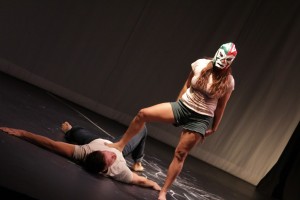
Blanca-Seb: Borderless. Presented at Ficho Festival 2017, with excerpts on the road for Caravanas Ficho
But for now the talking is done, and the show must go on. On this occasion, it’s not a street show. We set up the circus equipment and sound system in a big, high-ceilinged indoor hall. The Naga Collective girls have their Chinese Pole with them today, which is the subject of a great comic act circling around a race to get the pole erected, and then to see who will reach the ceiling first. Juggler and swing dancer extraordinaire, Paula Aviles, does a neat act that involves Charleston dancing whilst manipulating numerous objects. Also on the bill are Montreal hand-to-hand stars Julius & Cesar, who, after performing some jaw-dropping acrobalance moves, seemingly oblivious to the threat of the concrete floor below, get a couple of the young men in the audience up and involved in the act; and double act Blanca and Seb, who perform a section of their marvellous show Borderless, which explores and satirises their cultural heritage (she is Mexican, he is from the USA), and lampoons the current Trumpian rantings about walls and borders. As before, I open the show with my gentle little musical clown piece that ends in a collective waltz. Before I go on, someone says ‘I think you’ll have trouble getting these people up to dance with you’ but far from it – many are very happy to join in.
After the show, we’re invited to stay to eat a late lunch. It is an orderly, communal affair. Angelica gathers everyone – artists, volunteers, workers and centre users – into a big circle and does a short welcome to the centre, and a rundown of the ‘house rules’ which include the direction that women must always be treated with respect. She explains that she needs a number of teams of people. People volunteer to join the serving team, or the washing-up team, or the floor-sweeping team. That sorted, we queue up to get a hearty plate of meat, beans, rice and salad. Everyone plays by the rules, and we all happily work together to make the dining and clearing up go with a swing. After the meal, some head off, and others hang out in the small garden, smoking and chatting. I go to say goodbye to Angelica, and pick up a swathe of postcards bearing individual migrant’s stories. With the photos on the front of the card is the phrase Migrar es un Derecho. To migrate is a right.
Free movement, the right to work, the right to live without persecution… Well, of course! On our next Ficho Caravana road trip a few days later, we come up against a harrowing example of a human right I would never have expected to see denied. Water. We travel for a couple of hours out of Guadalajara to the Chapala lake, a popular tourist destination, then turn off the highway to take a steep and winding road up a hillside overlooking the lake. We are heading to the ironically-named Agua Caliente. This small village overlooks the sparkling blue lake, and traditionally has relied on the lake for its water supply. It takes its name from the hot springs next to the lake. Now, though, the lake water – which looks beautiful and inviting – is so polluted by industrial waste, including highly toxic metals, that it is dangerous to drink, even if boiled. But as there is no other water supply to the town, the people who live there have to use the lake water. The pueblo is well off the beaten track, with an Indigenous population who are mostly in the lower socio-economic group, so they have no real choice. We are travelling there in a convoy of cars, and the one I’m in includes an environmental scientist and political campaigner, who passes around a swathe of photocopied sheets and newspaper cuttings which expose the scandal of the water-less Agua Caliente, Unsurprisingly, the town has has seen a spate of cancers and birth defects as a result of drinking polluted water. Apparently, we’re told, nothing gets done about this because of the corruption of local officials, who accept bribes to rubber-stamp the industrialists’ polluting bi-products pouring into the lake, passing them as within agreed limits, which they obviously are not.
So here we are in Agua Caliente on a very sunny Sunday afternoon. Once again, we are parked up outside a church, where the street show will be. We are told by our community contact that one of the villagers has kindly agreed to the performers using her house as a changing room. We carry our bags down the steep concrete steps and enter the house, which is just one room divided into a living/sleeping area and an overstuffed storage space filled with packets of tostados, bottles of red chilli sauce, and cans of Coca Cola. We gather that this is the local store. Who needs water? Let them drink Coke! The woman of the house tells a troupe of small boys to go outside to play, which they do, staring at us wide-eyed as they leave. One sickly toddler stays dozing on the sofa, cuddling up to an even sicker looking dog. We are told we can use the bed to put our things on, so we push aside the bundle of threadbare sheets and well-worn T-shirts to make some space. Asking to use the bathroom, we are shown outside to the back of the house, overlooking the glistening lake, and carefully go down another steep set of concrete steps to a tiny curtained-off outhouse boasting an ancient toilet bowl with no water supply…
Once dressed in our finery, we go crowd-gathering, processing through the one-street town, up a winding dusty track lined with houses, some poorer than others. The lake is never out of sight for more than a few seconds, popping up between the houses on the left as we move ‘uptown’. The procession is led by Ana Cristina, from renowned Brazilian company Lume Teatro, who is beating a drum and singing. Mexican circus artist Blanca takes the baton and breaks into a lovely, repetitive, sing-song rhyme that the local children know and join in with. The rest of us sing along as best we can with the chorus, shaking tambourines, juggling clubs, or riding on each other’s shoulders. Clown and acrobat Daniel Salvi (also from Brazil) brings up the rear, standing in the back of a requisitioned pick-up truck with a bunch of young men from the town, calling on the driver to sound the horn, and shouting merrily at onlookers. We go right to the top of the town, where the houses stop, turn around and process back – by now we have a big gang of children with us, and people are lining the narrow street to cheer us on. Come to the circus, outside the church, we shout – and by the time we get back to our starting point we’ve gathered up a healthy sized crowd. We start the show. Mother Ginger and her Little Birds, Dulce with her ever-popular juggling act, Blanca and Seb’s beautiful acrobalance, an excerpt from Daniel’s lamp-post show O Poste (this particular scene a clever comic sketch involving a trick ladder), and Mariana Gabriel’s lovely, gentle clown Birota. Then, something odd happens. Mariana has the entranced crowd eating out of her hand when suddenly there is a disturbance and the children surrounding her speed off like a flock of starlings. They’ve headed towards a car with an open boot – the children have spied the bottles of water in the boot, and have gathered around the car to beg for water, in the way that children would perhaps beg for sweeties in a different setting. It is heartbreaking, and I just wish we’d been able to bring them gallons and gallons of water.
My fourth and last Caravana trip is also the last of the season, coming on the first of December, after the close of the Ficho Festival. Most of the international artists have already departed from Guadalajara, so for this one it’s me and the Mexicans: a group of core artists from Les Cabaret Capricho – the aforementioned founder members Cesar and Violeta (and how lovely to be working alongside them as artists, as well as producers!); regular collaborator Valeria Estrellas, a brilliant musician and clown; and contortionist-juggler Erándeni Nava Galindo, runner-up in the Concurso Nacional de Circo de Creacion (Mexico’s premiere competition for emerging contemporary circus performers), which had recently been presented as part of Ficho Festival.
This one is also outside of Guadalajara, in the mescal-brewing region of Tequila and Magdalena. Just as only sparkling wine made from grapes grown in Champagne can bear that name, so also only mescal made from the blue agave plants grown in the designated area circling the town of Tequila can bear that name. Magdalena is a few miles along the road, and boasts its own mescal, which is allegedly better than Tequila’s. We are here to perform outdoors (yes, outside the church) at 7pm, but have arrived much earlier in order for Cesar and team to meet with the workers and users of the local arts centre. I decide to take an afternoon stroll.
Magdalena is a pretty little town with a mixed population, neither rich nor poor. Its high street is a provincial mix: clothes shops selling garish Disney T-shirts, rainbow-striped ponchos and Barbie pink leggings; a cafe-bar keen to keep up with the times by offering cappuccino on its menu; and, because it’s December, hardware shops that have added flashing LED Christmas lights and plaster nativity sets to the displays of cheap Chinese kitchen appliances, bristly brooms and porcelain knick-knacks. At the far end of the main drag, beyond the church where our performance will be, is a town square with a bandstand in its centre. Old women sit out on benches, chatting and enjoying the last of the day’s sunshine; a group of men sporting white cowboy hats play a game of cards; and a few traders stop gathering up their wares as I pass by, hoping that the gringa will make a purchase of a bead bracelet or a leather handbag. As I return to the arts centre, it is dusk, and I peer in through the open windows to watch a dance class – it’s a form I’ve seen before and don’t know the name of, a kind of folkloric tap that has echoes of Flamenco (not least in the Fandango style lilt of the music), which I’d witnessed in full flight a week earlier at a Ficho Festival gig in a traditional Guadalajara cantina by a fabulous group of Mexican musicians who go out under the name Los Soneros de Tesechoacan. I learn that the Magdalena arts centre promotes participatory performance work and activities of all sorts, from folkloric music and dance to martial arts and contemporary circus.
Talking of which, here we are – ready for our last Ficho Caravana show. After dark, the space to the side of the main church, which was earlier being used for a basketball match, is now floodlit by bright lamps, which vie with the light from three brightly coloured crosses atop of three surrounding churches, not to mention an almost-full supermoon blazing in the night sky. An enormous crowd has gathered: the whole town must surely be here. Cesar, in his role of Omar the Impresario, moves those who are sitting along the back wall onto one of the other three sides. And on we go! Mother Ginger does her thing. Erándeni starts her fabulous contortion and object manipulation act by being carried on in a suitcase, out of which her feet, legs and eventually whole body gradually appear. Cesar/Omar charms the crowd with his juggling and clowning. Violeta and Valeria perform extracts from their two-woman Cabaret Capricho show Bruta, including the marvellously competitive getting-ever-drunker skit to I Put a Spell on You. Valeria the singing clown does a lovely solo piece in which she takes an audience member as her lover, and Violeta presents an eccentric dance with a coat, which she manages to wear in every way you could imagine, and some you couldn’t. And, after a fun-filled hour, it’s over. The crowd is happy, the booker is happy, we’re happy – and it’s time to take a bow. The Ficho Caravana ends on a high, and we pack away our frock-coats and net petticoats, remove the pancake from our faces, and set off on the road, back to Guadalajara.
Ficho Festival Internacional de Circo y Chou en Mexico took place in Guadalajara November 2017. The linked Caravanas Ficho programme took place in tandem to the Festival in Guadalajara, and also in other parts of Jalisco state, Mexico in November–December 2017. www.fichofest.com

